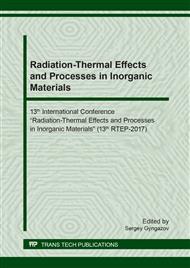[1]
A.V. Anikeenko, N.N. Medvedev, Structural and entropic insights into the nature of the random-close-packing limit, Phys. Rev E77 (2008) 031101.
DOI: 10.1103/physreve.77.031101
Google Scholar
[2]
A.V. Anikeenko, N.N. Medvedev, Investigation of the structure of packages of hard spheres near the Bernal density, Jour. Struct. Chem. 50(4) (2009) 787–794.
Google Scholar
[3]
V.N. Voloshin, Y.I. Naberuhin, Distribution of the lifetime of the hydrogen bond in computer models of water, Jour. Struct. Chem. 50(1) (2009) 84–95.
Google Scholar
[4]
J. Blakemore, Solid State Physics, Mir, Moscow, (1988).
Google Scholar
[5]
M.N. Magomedov, On the random packing of monatomic structures, Jour. Struct. Chem. 49(1) (2008) 164–167.
Google Scholar
[6]
A.M. Dobrotvorsky, D.V. Shirokov, The relationship between the atomic volume, the interatomic distance, the structural number in the crystalline structures of simple substances, Journal Physical Chemistry 74(12) (2000) 2184–2189.
Google Scholar
[7]
V.I. Kalikmanov, Mean-field kinetic nucleation theory, J. Chem. Phys. 124 (2006) 124505.
Google Scholar
[8]
V.I. Kalikmanov, J. Wolk, T. Kraska, Argon nucleation: Bringing together theory, simulations, and experiment, J. Chem. Phys. 128 (2008) 124506.
DOI: 10.1063/1.2888995
Google Scholar
[9]
N.M. Putintsev, D.N. Putintsev, Calculation of the thermodynamic and structural properties of liquid noble gases, Journal Physical Chemistry 88(3) (2014) 367–371.
DOI: 10.1134/s0036024414030200
Google Scholar
[10]
J. Hirschfelder, S. Curtiss, Byrd R. Molecular theory of gases and liquids, IL, Moscow, 196.
Google Scholar
[11]
P. Wang C. Song, H.A. Makse, Jamming II: A phase diagram for jammed matter, arXiv:0808.2196v1 [cond-mat.soft] (2008) 427-455.
Google Scholar
[12]
S.S. Nomoto, Note of the hole theory of liquids, Progress of Theoretical Physics 71(6) (1984) 1129–1141.
Google Scholar
[13]
G.A. Melnikov, V.N. Vervejko, Y.F. Melihov, Cluster model and infrared spectra of liquids, IOP Conference Series: Materials Science and Engineering 168(2017) 012021.
Google Scholar
[14]
G.A. Melnikov, Thermal conductivity of liquids in a cluster model, IOP Conference Series: Materials Science and Engineering 168(2017) 012020.
Google Scholar


